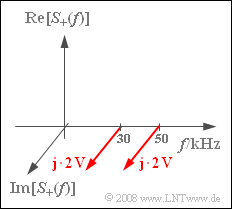Difference between revisions of "Aufgaben:Exercise 2.1: DSB-AM with Cosine? Or with Sine?"
m |
m |
||
| Line 35: | Line 35: | ||
<quiz display=simple> | <quiz display=simple> | ||
| − | { | + | {Find the spectrum $S(f)$. Which of the following statements are correct? |
|type="[]"} | |type="[]"} | ||
| − | + $S(f)$ | + | + $S(f)$ consists of four Dirac functions. |
| − | - | + | - All Dirac weights have the same magnitude $2\text{ V}$. |
| − | + | + | + All Dirac weights are imaginary. |
| − | { | + | {what is the modulated signal $s(t)$? Which statement is true? |
|type="()"} | |type="()"} | ||
+ Es handelt sich um ZSB–AM ohne Träger. | + Es handelt sich um ZSB–AM ohne Träger. | ||
- Es handelt sich um ZSB–AM mit Träger. | - Es handelt sich um ZSB–AM mit Träger. | ||
| − | { | + | {State the message signal frequency $f_{\rm N}$ . |
|type="{}"} | |type="{}"} | ||
$f_{\rm N} \ = \ $ { 10 3% } $\ \text{kHz}$ | $f_{\rm N} \ = \ $ { 10 3% } $\ \text{kHz}$ | ||
| − | { | + | {Determine the phases of the source and carrier signals. |
|type="{}"} | |type="{}"} | ||
| − | $ϕ_{\rm N} \ = \ $ { 0. } $\ \text{ | + | $ϕ_{\rm N} \ = \ $ { 0. } $\ \text{degrees}$ |
| − | $ϕ_{\rm T} \ = \ $ { 90 } $\ \text{ | + | $ϕ_{\rm T} \ = \ $ { 90 } $\ \text{degrees}$ |
| − | { | + | {What is the amplitude of the message signal? |
|type="{}"} | |type="{}"} | ||
$A_{\rm N} \ = \ $ { 4 3% } $\ \text{V}$ | $A_{\rm N} \ = \ $ { 4 3% } $\ \text{V}$ | ||
Revision as of 14:52, 19 November 2021
Let us consider the amplitude modulation of the source signal $q(t)$ with the carrier signal $z(t)$. These signals are given by:
- $$q(t) = A_{\rm N} \cdot \cos(2 \pi f_{\rm N} t + \phi_{\rm N})\hspace{0.05cm},$$
- $$z(t) = \hspace{0.15cm}1 \hspace{0.13cm} \cdot \hspace{0.1cm}\cos(2 \pi f_{\rm T} t + \phi_{\rm T})\hspace{0.05cm}.$$
The carrier frequency is known to be $f_{\rm T} = 40\text{ kHz}$. The other system parameters $A_{\rm N}$, $f_{\rm N}$, $ϕ_{\rm N}$ and $ϕ_{\rm T}$ are to be determined in this exercise.
The spectrum $S_+(f)$ of the analytical signal $s_+(t)$ at the modulator output is also given (see graph):
- $$S_+(f) = {\rm j}\cdot 2\,{\rm V} \cdot \delta ( f - f_{30} )+ {\rm j}\cdot 2\,{\rm V} \cdot \delta ( f - f_{50} )\hspace{0.05cm}.$$
Here, the abbreviations $f_{30} = 30\text{ kHz}$ and $f_{50} = 50\text{ kHz}$ are used.
As a reminder, the spectrum $S_+(f)$ is obtained from $S(f)$ by
- truncating the components at negative frequencies and
- doubling positive frequencies.
Hints:
- This exercise belongs to the chapter Double-Sideband Amplitude Modulation.
- Particular reference will be made to the pages Description in the frequency domain and Description in the time domain.
- The following trigonometric identities are given:
- $$\cos(\alpha)\cdot \cos(\beta) = {1}/{2} \cdot \big[ \cos(\alpha-\beta) + \cos(\alpha+\beta)\big ] \hspace{0.05cm}, \hspace{0.5cm} \cos(90^{\circ}- \hspace{0.05cm} \alpha) = \sin(\alpha) \hspace{0.05cm}, \hspace{0.5cm} \cos(90^{\circ}+ \hspace{0.05cm} \alpha) = -\sin(\alpha) \hspace{0.05cm}.$$
Questions
Musterlösung
- Bei positiven Frequenzen erhält man $S_+(f)$ aus $S(f)$ durch Verdoppelung.
- Daraus folgt, dass die Impulsgewichte von $S(f)$ nur jeweils ${\rm j} · 1 \text{ V}$ sind.
- Aufgrund des Zuordnungssatzes muss $S(f)$ eine ungerade Funktion sein.
- Deshalb besitzt $S(f)$ noch zwei weitere Diracfunktionen bei $f = -f_{30}$ und $f = -f_{50}$, jeweils mit dem Gewicht $-{\rm j} · 1 \text{ V}$:
- $$S(f) = 1\,{\rm V} \cdot \big[ {\rm j}\cdot \delta ( f - f_{30} )-{\rm j} \cdot \delta ( f + f_{30} )+ {\rm j} \cdot \delta ( f - f_{50} )-{\rm j} \cdot \delta ( f + f_{50} )\big] \hspace{0.05cm}.$$
(2) Die Fourierrücktransformation von $S(f)$ führt mit $ω_{30} = 2π · f_{30}$ und $ω_{50} = 2πf_{50}$ zu folgendem Signal:
- $$ s(t) = -2\,{\rm V} \cdot \sin(\omega_{\rm 30} t )-2\,{\rm V} \cdot \sin(\omega_{\rm 50} t )\hspace{0.05cm}.$$
- Dieser enthält keinen Anteil bei der Trägerfrequenz $f_{\rm T} = 40\text{ kHz}$, so dass die erste Aussage zutrifft.
(3) Bei ZSB–AM ohne Träger beinhaltet $s(t)$ nur die beiden Frequenzen $f_{\rm T} – f_{\rm N}$ und $f_{\rm T} + f_{\rm N}$.
- Daraus folgt mit $f_{\rm T} = 40\text{ kHz}$ für die Nachrichtenfrequenz: $f_{\rm N} \hspace{0.05cm}\underline {= 10\ \rm kHz}.$
(4) Bei ZSB–AM ohne Träger gilt:
- $$s(t) = q(t) \cdot z(t) = A_{\rm N} \cdot \cos(\omega_{\rm N} t + \phi_{\rm N})\cdot \cos(\omega_{\rm T} t + \phi_{\rm T})$$
- $$\Rightarrow \hspace{0.5cm} s(t) = \frac{A_{\rm N}}{2} \cdot \left[ \cos\left((\omega_{\rm T} +\omega_{\rm N})\cdot t + \phi_{\rm T}+ \phi_{\rm N}\right) + \cos\left((\omega_{\rm T} -\omega_{\rm N})\cdot t + \phi_{\rm T}- \phi_{\rm N}\right) \right] \hspace{0.05cm}.$$
- Ein Vergleich mit dem Ergebnis der Teilaufgabe (2) zeigt, dass gelten muss:
- $$\cos(\omega_{\rm 30} \cdot t + \phi_{\rm T}- \phi_{\rm N}) = -\sin(\omega_{\rm 30} \cdot t )\hspace{0.05cm},$$
- $$\cos(\omega_{\rm 50} \cdot t + \phi_{\rm T}+ \phi_{\rm N}) = -\sin(\omega_{\rm 50} \cdot t ) \hspace{0.05cm}.$$
- Beide Gleichungen sind gleichzeitig nur mit der Phase $ϕ_{\rm N} \hspace{0.05cm}\underline {= 0}$ zu erfüllen.
- Aus der letzten angegebenen trigonometrischen Beziehung folgt außerdem $ϕ_{\rm T} \hspace{0.05cm}\underline {= 90^\circ} = π/2$.
(5) Ein Vergleich der Ergebnisse aus (2) und (4) führt auf $A_{\rm N} \hspace{0.05cm}\underline {= 4 \ \rm V}$. Damit lauten die Gleichungen der an der Modulation beteiligten Signale:
- $$q(t ) = 4\,{\rm V} \cdot \cos (2 \pi \cdot 10\,{\rm kHz} \cdot t) \hspace{0.05cm},$$
- $$z(t) = 1 \cdot \cos (2 \pi \cdot 40\,{\rm kHz} \cdot t + 90^{\circ}) = -\sin (2 \pi \cdot 40\,{\rm kHz} \cdot t )\hspace{0.05cm}.$$
